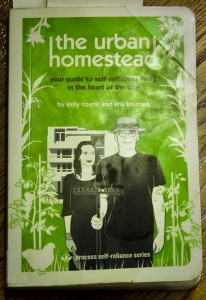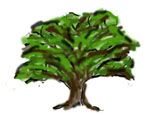I’ll start out by saying, firstly, that I borrowed this book from the library, but since it’s a goldmine of information and reference for the beginner urban homesteader, I plan on purchasing a copy.
My apologies for the less-than-stellar photo. My excuse is that it’s difficult to get a good photo of a slightly tattered (read: well-loved?) paperback from the library. 😉 This, by the way, is the 2008 version. There is a 2010 version that comes out on June 1 of this year, so I may wait for that.
The co-authors are a Los Angeles wife and husband who grow as much of their own food as possible, forage edible plants from the urban landscape, compost, conserve energy, make many things (household items, food, etc.) themselves, keep animals, can food, make yogurt, use greywater, take public transit, etc. They give step-by-step instructions for almost everything they do and they tell you how to find the information they couldn’t pack into the book. They do all of this while living in a small house on a small urban lot, and their writing is witty and engaging and uses critical thought as they describe doing all these things.
In short, this is my kind of book.
If you’ve been doing this sort of thing for a while or if you have a lot of space, this may not be the book for you. However, if you want a wide range of starter ideas that you can implement in limited space, you can get plenty of information from this book. You don’t have to follow every single suggestion, and chances are anyway that you won’t, can’t, or both. But you can glean plenty of ideas for smaller-scale, simpler things you can do right now. For example, gathering water from the tub in a bucket while you wait for it to heat up for your shower provides you with water for flushing the toilet, watering your garden, or doing your dishes, and it doesn’t take lots of expensive equipment, time, or knowledge either. Making sourdough starter doesn’t require a degree in chemistry – just flour, water, a container, and a little bit of time every day will do the trick. This book provides plenty of instruction for these “small” changes.
For me personally, the most immediately useful sections are the ones on growing food, making things such as yogurt, labaneh, butter, fruit preserves, pickles, and sourdough starter, and preserving food. The cleaning products section is mostly a rehash for me, as I’ve been using homemade and environmentally-friendly cleaning products for many years and some of the bigger projects will take some time and experience I don’t yet have.
What would I like to have seen more of? Techniques for growing in late fall and winter, for one. I don’t expect the authors have much experience with that since they live in Los Angeles, but here in Chicago, that sort of information would come in handy. Our growing season is much shorter than those in more temperate climes, so knowing how to extend it and with which types of plants is information many of us would want.
This book is still worth reading even without cold weather techniques for growing food. 4.5 out of 5 stars.
You can also check out the authors’ blog here.






I’m going to have to check this out.